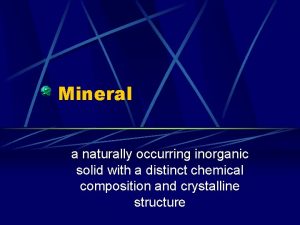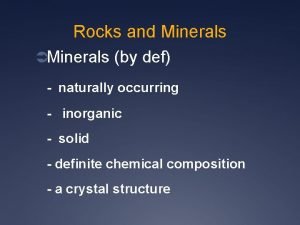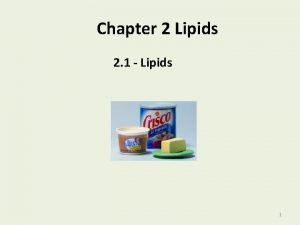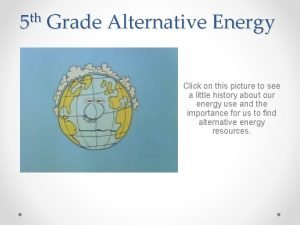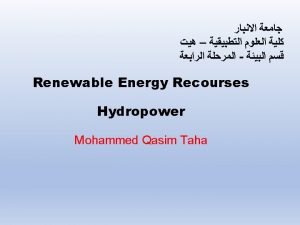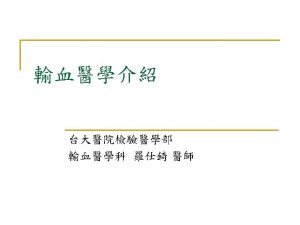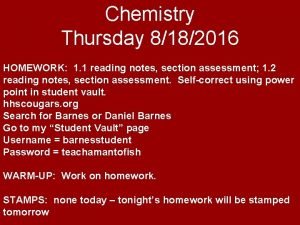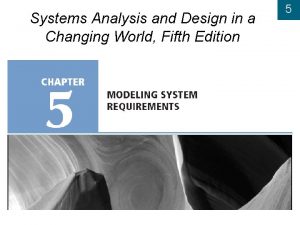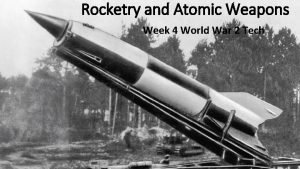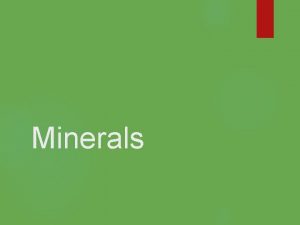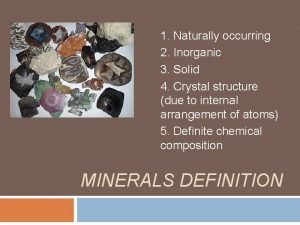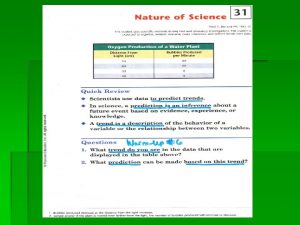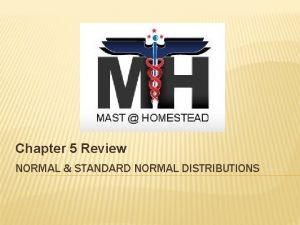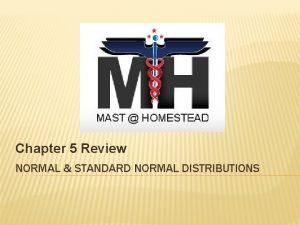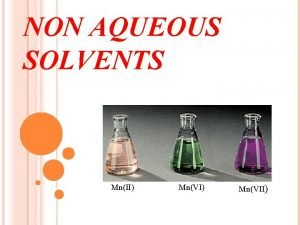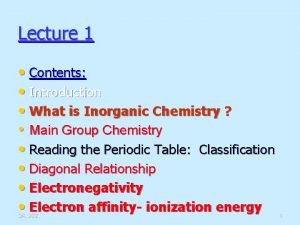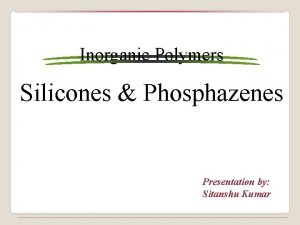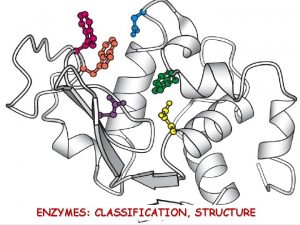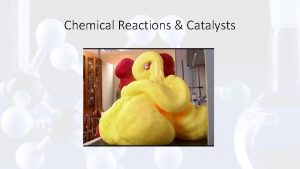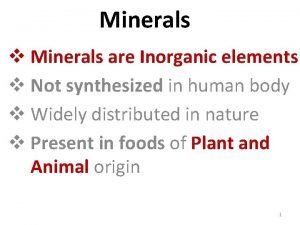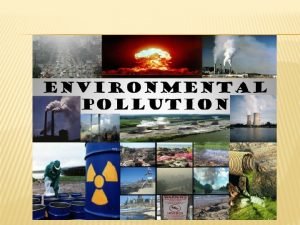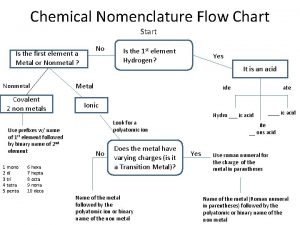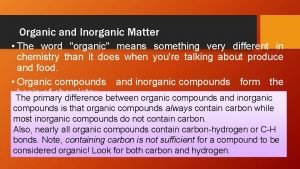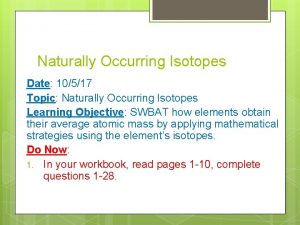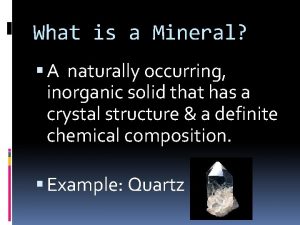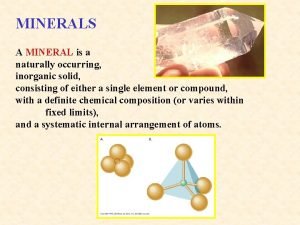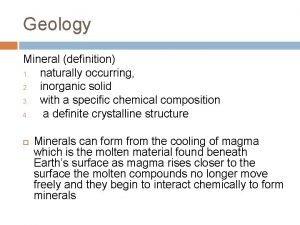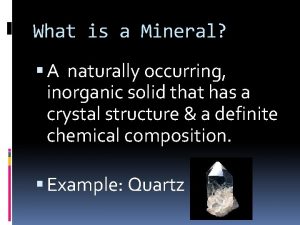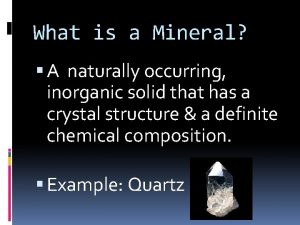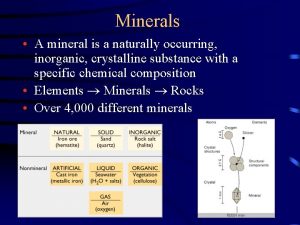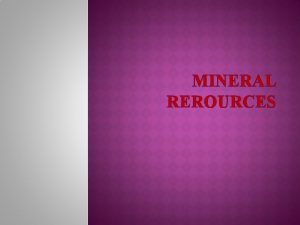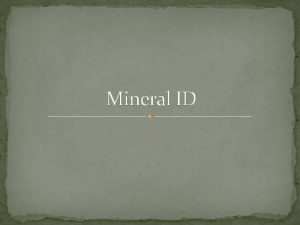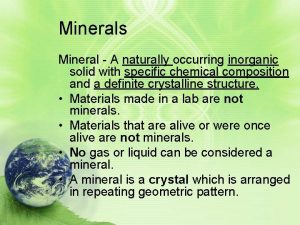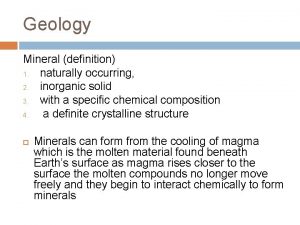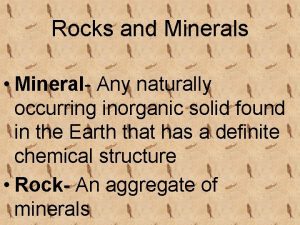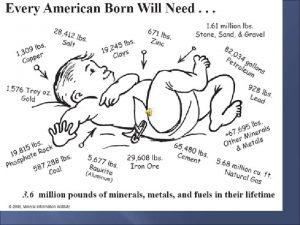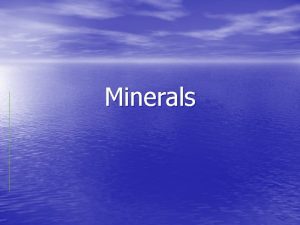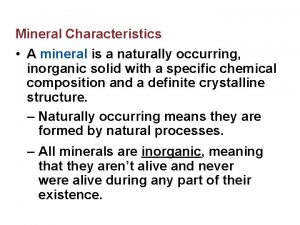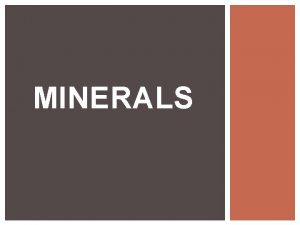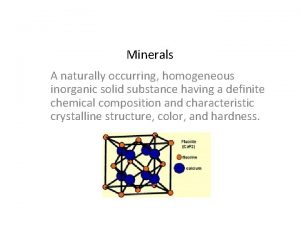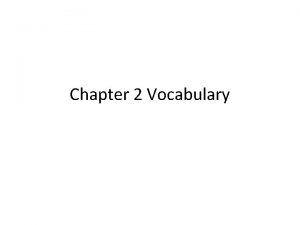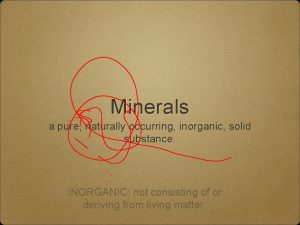What is a Mineral n Naturally occurring inorganic





























- Slides: 29


What is a Mineral? n Naturally occurring, inorganic solid with a crystal structure and definite chemical composition. Pyromorphite

What do all minerals have in common? All: 1. 2. 3. 4. 5. Are formed by natural processes. Are NOT alive and NEVER were alive Have a definite volume and shape Are elements or compounds with a unique chemical makeup (2 or more elements) Are made up of particles that are arranged in a pattern that is repeated over and over (called a CRYSTAL)

How do minerals form? n 1) Cooling of magma (hot, liquid rock and minerals inside the earth (from the mantle)) Fast Cooling = No Crystals (mineraloids) n Medium Cooling = small crystals n Slow Cooling = large crystals n

How do minerals form? n n n 2) Elements dissolved in liquids (usually water) 3) Changes in pressure and temperature 4) formation of hydrothermal solutions -when hot solutions touch existing minerals, chemical reactions take place and form new minerals.

1. What element are diamonds made from? 2. What do all crystals have in common?

Groups of Minerals n Minerals are grouped by the elements they are made of. Beryl (Emerald) Calcite Amethyst

Mineral Group Silicates Characteristics n. Contain oxygen & silica n. The most abundant group of minerals MICA Examples Quartz, mica Quartz

Mineral Group Carbonates Characteristics n. Carbon Examples & Calcite (Ca. CO 3) oxygen and a positive ion, such as calcium Calcite with Duftite inclusions

Mineral Group Oxides Characteristics Metallic ion and oxygen Examples Hematite (Fe 2)O 3

Mineral Group Sulfides Characteristics Sulfur and a metallic ion Examples Galena (Pb. S)

Mineral Group Sulfates Barite on Calcite Ba. So 4 / Ca. CO 3 Characteristics Metallic Examples ion, Barite (Ba. SO 4) Sulfur & oxygen Barite Ba. So 4

Mineral Group Halides Characteristics Halogen ions Examples Flourite (Ca. F 2) Halite (Na. Cl)

Mineral Group Characteristics n. Make up only 5% of the Earth’s crust n. Single elements Native Elements Silver Examples iron, copper, gold, silver, diamonds, rubies Copper Diamond Gold Ruby Iron

QUIZ BREAK

How many mineral groups can you name? Can you tell me some of the examples?

Physical Properties of Minerals (can be used to identify the mineral) Color n Can be misleading n Can vary with the type of impurities

Physical Properties of Minerals (can be used to identify the mineral) Streak n The color of the powdered form of the mineral n The color of the streak can be different than the mineral n Minerals must be softer than the streak plate

Streak…can help identify quartz http: //www. childrensmuseum. org/geomysteries/cube/b 3. html

Physical Properties of Minerals (can be used to identify the mineral) Luster n Surface reflection n metallic = shiny like metal n non-metallic = dull, non-shiny surface Pyrite has a metallic luster Calcite has a non-metallic luster

Physical Properties of Minerals (can be used to identify the mineral) Hardness n How easily a mineral scratches materials n Mohs Hardness Scale from 1 (softest) to 10 (hardest) n Test by seeing if the mineral can scratch different objects (like human fingernail, copper, penny, glass, steel file) n

Find out more… n “Electronic” Hardness Test http: //www. childrensmuseum. org/geomy steries/cube/b 2. html

Physical Properties of Minerals (can be used to identify the mineral) Cleavage & Fracture The way the mineral breaks n Cleavage—minerals break along smooth, flat surfaces and every fragment has the same general shape n Fracture—minerals that break at random with rough or jagged edges n


Crystal form n If space is not restricted, a mineral will exhibit a crystal pattern with a definite number of sides and specific angles.

Cleavage or Fracture? 1. 4. 2. 3.

Physical Properties of Minerals (can be used to identify the mineral) Other Properties Specific gravity (*excellent clue to mineral’s identity) http: //www. childrensmuseum. org/geomysteries/cube/b 4. html n Attraction to magnets n Bending of light n Reaction with hydrochloric acid n Smell & taste n

1. If a mineral can scratch your fingernail, the mineral is ________ than your fingernail. 2. What is luster?

 Naturally occurring inorganic solid
Naturally occurring inorganic solid Minerals def
Minerals def Steroid nucleus
Steroid nucleus Biofuels pros and cons
Biofuels pros and cons Naturally occurring areas of hydrothermal resources
Naturally occurring areas of hydrothermal resources Naturally occurring areas of hydrothermal resources
Naturally occurring areas of hydrothermal resources H
H Largest naturally occurring element
Largest naturally occurring element Is a naturally occurring association among specific things
Is a naturally occurring association among specific things Largest naturally occurring element
Largest naturally occurring element A narrow channel or slab of a mineral
A narrow channel or slab of a mineral Inorganic mineral definition
Inorganic mineral definition What process is occurring
What process is occurring Find the probability of z occurring in the indicated region
Find the probability of z occurring in the indicated region Find the probability of z occurring in the indicated region
Find the probability of z occurring in the indicated region Organic molecules vs inorganic molecules
Organic molecules vs inorganic molecules Charring test of organic and inorganic compounds
Charring test of organic and inorganic compounds Liquid ammonia as non aqueous solvent
Liquid ammonia as non aqueous solvent Inert pair effect
Inert pair effect Organic growth vs inorganic growth
Organic growth vs inorganic growth Inorganic polymer
Inorganic polymer Enzymes classification
Enzymes classification Inorganic catalyst vs enzyme
Inorganic catalyst vs enzyme Iron deficiency anemia smear
Iron deficiency anemia smear Ch4o organic or inorganic
Ch4o organic or inorganic What is inorganic pollution
What is inorganic pollution Organic and inorganic nutrients
Organic and inorganic nutrients Nomenclature flowchart
Nomenclature flowchart Advanced inorganic chemistry lecture notes
Advanced inorganic chemistry lecture notes What is inorganic matter
What is inorganic matter
